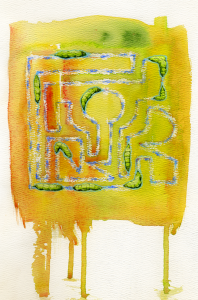A Paper Presented to the League of Astrobiological Studies, 2015–Highlights from the Journal of Dr. Louise Mendant: First Investigations into “Mendant’s Maggots” by Dr. Bryce Ellicott, as provided by Dr. J.A. Grier
Art by Leigh Legler
As the scientific community is now aware, “Mendant’s Maggots”–once thought to be fictional creatures–have recently been proven to truly exist. The last remnants of this intriguing species were recovered from the burned and long ignored laboratory of Dr. Louise Mendant. Dr. Mendant’s original reports and papers dealing with these small creatures were dismissed as whimsy. Our laboratory has, however, recovered viable specimens, and thanks to funding through NASA and the NSF, we have reinitiated those studies begun by Dr. Mendant.
We feel it fitting to present here highlights from her experimental journal. Lost more than one hundred years ago, the journal is a thought-provoking account of the procedures followed by this renowned scientist. While no doubt many of her entries remain fanciful and unsophisticated by present day standards, the journal helps to emphasize the importance of these highly unusual creatures. We beg the forgiveness of readers for any difficulties with the text. The original journal was smudged and smoke damaged, and some passages were lost entirely.
Dr. Louise Mendant’s Experimental Journal
June 21, 1895
I was thrilled to be presented today with the only surviving sample of the small green grubs retrieved from Hartford Estate. You will recall these grubs were found inside of a dark rock the young Master Hartford was using for lawn bowling. Knowing my interest in unusual animals and plants of all kinds, the boy’s father, Daniel Hartford, presented the grubs and their rocky home to me this morning. He seemed both unhappy and relieved to be rid of them. I know of his own deep interest in science, and his reluctance to part with the small beasts was tangible. Alas, his wife Jenna has been complaining of headaches since the time the rock split open on a particularly good throw last week. Since she rather irrationally blames the rock, Daniel was forced to hand it over to me. It is to my gain, and I promised to share my results with him as frequently as possible. He begged to be allowed to peek in on my work from time to time, and this request I granted with enthusiasm.
July 1, 1895
As was reported to me by Daniel Hartford, the small green grubs seem to require no food or water to survive, but die within minutes if removed from the surface of the black rock. This makes study quite difficult. A grub can be pulled away and placed under a microscope, but only for mere moments, and then it must be immediately returned to the rock. With caution and patience, I have been able to sketch the larger structures. They are of the same approximate size and shape as common maggots, yet are bright green.
July 3, 1895
Daniel visited me in my laboratory today, and we both spent time simply staring upon the maggots and pondering their significance. How amazing to find a creature that, like a plant, does not seem to need to eat! Perhaps this green color is indeed the same chemical found in plants, and they metabolize in the same fashion. Yet, even plants require water. Daniel left at sundown, but I worked well into the night.
July 8, 1895
The maggots continue to show no interest in food or water, decayed or otherwise. No offering of any kind has been ingested, although they do seem to have mouth-like structures. Their only activity is to wander over the surface of the inside of the rock in repeating patterns. This no doubt involuntary, repetitive activity leads me to believe they are leaving behind some sort of chemical trail, much in the way ants might follow one another in a long line. Still, the patterns are fascinating, and I find myself watching the maggots wander for hours, and scarcely notice the time passing.

I immediately recognized drawings of the patterns the maggots make when they move, and was about to compliment Daniel on his accuracy when Jenna interrupted. Apparently they had been drawn by her son, and not by Daniel at all. Jenna accused Daniel of “wasting the boy’s time and energy” by teaching him these “useless patterns.”
To read the rest of this story, check out the Mad Scientist Journal: Autumn 2013 collection.
Dr. Ellicott is Director of Studies of Extremeophile Life at the Cumberland Astrobiological Laboratory.
Dr. J.A. Grier is a planetary scientist, poet, and wine lover. She spends her time penning odd articles, reading strange stories, comparing vintages, and looking at impact craters on other worlds. She throws a fabulous Halloween party every year where one room is decorated entirely in eyeballs. Her babblings can be found at www.onewritersmind.blogspot.com and @grierja on Twitter.
Leigh’s professional title is “illustrator,” but that’s just a nice word for “monster-maker,” in this case. More information about them can be found at http://leighlegler.carbonmade.com/.
Follow us online: